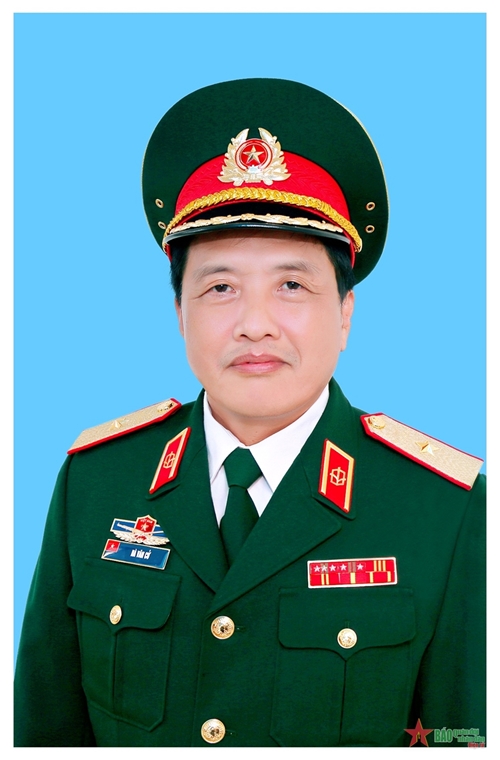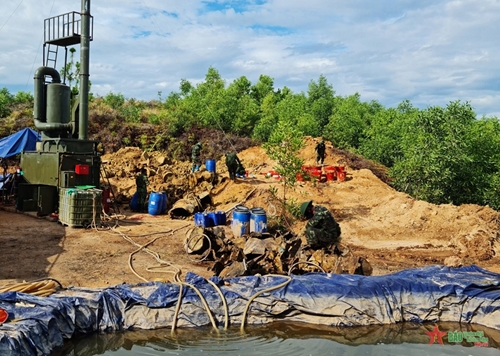The People’s Army Newspaper presents an interview on the issue with Major General Ha Van Cu, Commander of the Chemical Corps and Director of the National Action Center for Toxic Chemicals and Environmental Treatment (NACCET).
    |
 |
|
Major General Ha Van Cu, Commander of the Chemical Corps and Director of the National Action Center for Toxic Chemicals and Environmental Treatment (NACCET) |
Reporter: Many people do not know about the scale and consequences of chemical war that the U.S. troops conducted in Vietnam. Should we provide more information about this war?
Major General Ha Van Cu: That’s right! The chemical war that the U.S. military and its allies conducted in Vietnam was the largest and longest one. It caused the direst consequences in the history of humankind. From 1961 to 1971, the U.S. military used more than 80 million liters of herbicides, 44 million liters of which was agent orange (AO) containing nearly 370 kilograms of dioxin, in Southern Vietnam, according to the statistics released at the international seminar themed “Assessing consequences of AO/Dioxin that was used by the U.S. in the War in Vietnam” held in Hanoi in August, 2016.
The U.S. military also sprayed 9,000 tons of CS toxic chemical over the Southern region, causing environmental pollution scattered in provinces and cities of military regions 4, 5, 7, and 9. As a result, 4.8 million Vietnamese people were exposed to �AO/dioxin, and more than 3 million of them were victims, many of whom are dead and others are struggling with serious diseases and many women cannot enjoy the happiness of being a wife or a mother. Many children were born with deformities.
Reporter: On June 1, 2012, the Prime Minister issued Decision 651/QD-TTg approving the national plan on basically settling the consequences of toxic chemicals used by the U.S. troops during the war in Vietnam by 2015 with a vision towards 2020. How did the Chemical Corps implement that plan?
Major General Ha Van Cu: The Party, State and military always pay much attention to settling post-war toxic chemicals’ consequences. After the Prime Minister’s decision was signed, the defense ministry’s leaders issued Decision No.3490/QD-BQP on September 16, 2013, approving the ministry’s action plan on basically overcoming the consequences of toxic chemicals used by the U.S. troops during the war in Vietnam by 2015 with a vision towards 2020 and assigning relevant units to undertake the mission.
Since 2012, the Chemical Corps has collaborated with functional agencies to conduct three projects on collecting and treating a large amount of CS toxin and ammunition containing CS left after the war.
    |
 |
|
Troops of the Chemical Corps process post-war toxic chemicals in Thua Thien Hue province. |
The corps has collaborated with numerous agencies, localities and international organizations to investigate, evaluate and zone off the areas contaminated with AO/Dioxin at military airfields and field airports.
Several projects can be named such as the second phase of the project on dioxin contamination remediation at Bien Hoa airport, the assessment of land contamination level because of herbicides containing dioxin and asen in several field airports in military regions 4, 5, 7 and 9, the project on dioxin contamination remediation at A So Airport in A Luoi district, Thua Thien Hue province, and so on.
Reporter: What difficulties have you faced during the implementation of the projects, sir?
Major General Ha Van Cu: We have faced numerous hardships when implementing the projects. Firstly, the area of land contaminated with toxic chemicals is large and irregularly distributed, so it is difficult for us to assess the overall scale. Secondly, the processing area is large while the terrain is complicated, so we have to do it manually in many places. Thirdly, we have only mastered the technologies to thoroughly treat CS toxin and hydrolysis products of CS, not technologies to deal with AO/Dioxin. Currently, studies on Vietnam's treatment technology of AO/Dioxin are still in the experimental stage and cannot be applied on a large scale. The budget for the treatment project of post-war toxic chemicals is limited.
Reporter: What are major tasks of the Chemical Corps in the coming time, sir?
Major General Ha Van Cu: After 10 years of implementing Decision 651, the Prime Minister signed Decision No.2215/QD-TTg on issuing a national action plan on overcoming consequences of post-war AO/dioxin in the 2021-2030 period. In addition, the defense minister issued Circular No.15/2022/TT-BQP on promulgating regulations of the Vietnam People’s Army on environmental protection. According to these documents, the Chemical Corps is assigned with numerous tasks, especially the mastering of treatment technologies of war-left toxic chemicals. With the role of the National Action Center for Toxic Chemicals and Environmental Treatment, we focus on several key missions such as providing timely recommendations for the leaderships of the Ministry of National Defense and other relevant sectors while continuing accelerating cooperation with foreign partners in implementing the ongoing projects in Phu Cat Airport, treating CS toxin in contaminated areas, supporting affected victims nationwide, and building a database on managing the settlement of consequences of war-left toxic chemicals. On the other hand, we pay more attention to improving capabilities for staff, recruiting more qualified personnel, and enhancing international cooperation in training to fulfill our assigned tasks.
Reporter: Thank you so much, sir!
Translated by Trung Thanh